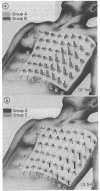Abstract
In a consecutive series of 56 patients with acute myocardial infarction, ST segment depression and elevation in the electrocardiographic limb leads I, II, and III were summated for each patient before and immediately after intracoronary streptokinase infusion and the results compared with the angiographic findings. Forty three patients had angiographically confirmed reperfusion of an initially occluded vessel and showed a significant decrease in summated ST shift. The ST segment changes in the limb leads virtually returned to normal in all 43 patients, and in most, inverted T waves developed. Thrombolysis was unsuccessful in 10 patients, and the infarct related coronary artery was already patent in three. When these two groups are combined, all 13 patients without reperfusion showed no significant change in summated ST segment shift. During percutaneous transluminal angioplasty inflation of the balloon in the vessel that was previously occluded simulated reocclusion and was followed by new ST elevation if the artery supplied viable myocardium. In a further consecutive study of 54 patients with anterior myocardial infarction, the precordial R waves and Q waves were studied over the four to six months following infarction using a standardised 48 electrode mapping system. All patients underwent a repeat angiogram after four to six months. In 36 patients the infarct related vessel was patent. They showed a significant mean increase in summated precordial R wave amplitude and a reduction in the mean number of precordial leads without R waves. In 18 patients with unsuccessful thrombolysis or reocclusion there was a further reduction in mean summated R wave amplitude and an increased number of precordial leads not showing R waves. Precordial R wave mapping seems to be a valuable non-invasive method of assessing the salvage of myocardium after reperfusion and the damage caused by reocclusion. Loss of R waves in the acute phase of myocardial infarction does not necessarily mean an irreversibly damaged myocardium.
Full text
PDF




Images in this article
Selected References
These references are in PubMed. This may not be the complete list of references from this article.
- Anderson J. L., Marshall H. W., Bray B. E., Lutz J. R., Frederick P. R., Yanowitz F. G., Datz F. L., Klausner S. C., Hagan A. D. A randomized trial of intracoronary streptokinase in the treatment of acute myocardial infarction. N Engl J Med. 1983 Jun 2;308(22):1312–1318. doi: 10.1056/NEJM198306023082202. [DOI] [PubMed] [Google Scholar]
- Bateman T., Gray R., Maddahi J., Rozanski A., Raymond M., Berman D. Transient appearance of Q waves in coronary disease during exercise electrocardiography: consideration of mechanisms and clinical importance. Am Heart J. 1982 Jul;104(1):182–184. doi: 10.1016/0002-8703(82)90670-6. [DOI] [PubMed] [Google Scholar]
- Blanke H., Scherff F., Karsch K. R., Levine R. A., Smith H., Rentrop P. Electrocardiographic changes after streptokinase-induced recanalization in patients with acute left anterior descending artery obstruction. Circulation. 1983 Aug;68(2):406–412. doi: 10.1161/01.cir.68.2.406. [DOI] [PubMed] [Google Scholar]
- Essen R., Merx W., Effert S. Spontaneous course of ST-segment elevation in acute anterior myocardial infarction. Circulation. 1979 Jan;59(1):105–112. doi: 10.1161/01.cir.59.1.105. [DOI] [PubMed] [Google Scholar]
- Gillmann H., Colberg K., Keller H. P., Orth H. F., Börner W., Fritze E., Gebauer D., Grosser K. D., Heckner F., Körtge P. Zur fibrinolytischen Behandlung des akuten Herzinfarktes. II. Deutsch-schweizerische Gemeinschaftsstudie. 2. Ergebnisse der elektrokardiographischen Untersuchungen. Z Kardiol. 1973 Mar;62(3):193–214. [PubMed] [Google Scholar]
- Haiat R., Chiche P. Transient abnormal Q waves in the course of ischemic heart disease. Chest. 1974 Feb;65(2):140–144. doi: 10.1378/chest.65.2.140. [DOI] [PubMed] [Google Scholar]
- Hillis L. D., Askenazi J., Braunwald E., Radvany P., Muller J. E., Fishbein M. C., Maroko P. R. Use of changes in the epicardial QRS complex to assess interventions which modify the extent of myocardial necrosis following coronary artery occlusion. Circulation. 1976 Oct;54(4):591–598. doi: 10.1161/01.cir.54.4.591. [DOI] [PubMed] [Google Scholar]
- Kalbfleisch J. M., Shadaksharappa K. S., Conrad L. L., Sarkar N. K. Disappearance of the Q-deflection following myocardial infarction. Am Heart J. 1968 Aug;76(2):193–198. doi: 10.1016/0002-8703(68)90194-4. [DOI] [PubMed] [Google Scholar]
- Klein H. O., Gross H., Rubin I. L. Transient electrocardiographic changes simulating myocardial infarction during open-heart surgery. Am Heart J. 1970 Apr;79(4):463–470. doi: 10.1016/0002-8703(70)90251-6. [DOI] [PubMed] [Google Scholar]
- Lambertz H., Schweizer P., Krebs W., Merx W., Erbel R., von Essen R., Uebis R., von Erckelenz H., Meyer J., Effert S. Echokardiographische Verlaufskontrolle des akuten Myokardinfarktes nach intrakoronarer Streptolysebehandlung. Z Kardiol. 1984 May;73(5):321–326. [PubMed] [Google Scholar]
- Meller J., Conde C. A., Donoso E., Dack S. Transient Q waves in Prinzmetal's angina. Am J Cardiol. 1975 May;35(5):691–695. doi: 10.1016/0002-9149(75)90058-2. [DOI] [PubMed] [Google Scholar]
- ROESLER H., DRESSLER W. Transient electrocardiographic changes identical with those of acute myocardial infarction accompanying attacks of angina pectoris. Am Heart J. 1954 Apr;47(4):520–526. doi: 10.1016/0002-8703(54)90234-3. [DOI] [PubMed] [Google Scholar]
- SHAW C. M., Jr, GOLDMAN A., KENNAMER R., KIMURA N., LINDGREN I., MAXWELL M. H., PRINZMETAL M. Studies on the mechanism of ventricular activity. VII. The origin of the coronary QR wave. Am J Med. 1954 Apr;16(4):490–503. doi: 10.1016/0002-9343(54)90364-2. [DOI] [PubMed] [Google Scholar]
- Selwyn A. P., Ogunro E., Shillingford J. P. Loss of electrically active myocardium during anterior infarction in man. Br Heart J. 1977 Nov;39(11):1186–1191. doi: 10.1136/hrt.39.11.1186. [DOI] [PMC free article] [PubMed] [Google Scholar]
- von Essen R., Hinsen R., Louis R., Merx W., Silny J., Rau G., Effert S. On-line monitoring of multiple precordial leads in high risk patients with coronary artery disease--a pilot study. Eur Heart J. 1984 Mar;5(3):203–209. doi: 10.1093/oxfordjournals.eurheartj.a061637. [DOI] [PubMed] [Google Scholar]
- von Essen R., Merx W., Doerr R., Effert S., Silny J., Rau G. QRS mapping in the evaluation of acute anterior myocardial infarction. Circulation. 1980 Aug;62(2):266–276. doi: 10.1161/01.cir.62.2.266. [DOI] [PubMed] [Google Scholar]




